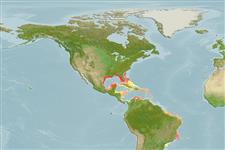Common names from other countries
Environment: milieu / climate zone / depth range / distribution range
Οικολογία
Θαλασσινό(ά) Υφαλόφιλο(α); εύρος βάθους 0 - 110 m. Tropical; 32°N -
Western Atlantic: Bermuda, Georgia and northeastern Gulf of Mexico in USA.
Μέγεθος / Βάρος / Age
Maturity: Lm ? range ? - ? cm
Max length : 7.5 cm TL αρσενικό/απροσδιόριστο; (Ref. 7251)
Μαλακές ραχιαίες ακτίνες (συνολικά) : 13 - 17; Εδρικές άκανθες: 2; Μαλακές εδρικές ακτίνες: 20 - 23. Species distinguished by: cirrus on eye present, longer than eye diameter in males (and often in females) and arising from single base; supraorbital cirrus distinctly banded, up to 3 times as long as eye diameter; no bony ridges on rear half of interorbital region; head smooth anteriorly, never spiny; males without flag-like flap on base of first dorsal-fin spine; segmented dorsal-fin rays 13 to 17; total dorsal-fin elements 30 to 38; pectoral-fin rays usually 14; anal-fin rays 20 to 23; 3 obvious segmented pelvic-fin rays (third ray goes 4 or fewer times in length of longest); tip of lower jaw not projecting beyond tip of upper jaw and without fleshy projection; no stripe or series of dark blotches on head and body; one row of teeth on each palatine bone. Common amongst Chaenopsids: small elongate fishes; largest species about 12 cm SL, most under 5 cm SL. Head usually with cirri or fleshy flaps on anterior nostrils, eyes, and sometimes laterally on nape; gill membranes continuous with each other across posteroventral surface of head. Each jaw with canine-like or incisor-like teeth anteriorly; teeth usually also present on vomer and often on palatines (roof of mouth). Dorsal-fin spines flexible, usually outnumbering the segmented soft rays, spinous and segmented-rayed portions forming a single, continuous fin; 2 flexible spines in anal fin; pelvic fins inserted anterior to position of pectoral fins, with 1 spine not visible externally; all fin rays, including caudal-fin rays, unbranched (simple). Lateral line absent. Scales absent (Ref.52855).
Found in intertidal areas in Bermuda. Occurs in deeper water from 30-110 m in USA.
Life cycle and mating behavior
Maturities | Αναπαραγωγή | Spawnings | Egg(s) | Fecundities | Προνύμφες
Robins, C.R. and G.C. Ray, 1986. A field guide to Atlantic coast fishes of North America. Houghton Mifflin Company, Boston, U.S.A. 354 p. (Ref. 7251)
IUCN Red List Status (Ref. 130435)
CITES (Ref. 128078)
Not Evaluated
Threat to humans
Harmless
Human uses
Εργαλεία
Special reports
Download XML
Διαδικτυακές πηγές
Estimates based on models
Preferred temperature (Ref.
115969): 22.1 - 27.5, mean 25.6 (based on 156 cells).
Phylogenetic diversity index (Ref.
82804): PD
50 = 0.5000 [Uniqueness, from 0.5 = low to 2.0 = high].
Bayesian length-weight: a=0.00457 (0.00183 - 0.01143), b=3.08 (2.86 - 3.30), in cm Total Length, based on LWR estimates for this (Sub)family-body shape (Ref.
93245).
Τροφικό Επίπεδο (Ref.
69278): 3.6 ±0.5 se; based on size and trophs of closest relatives
Fishing Vulnerability (Ref.
59153): Low vulnerability (10 of 100).
